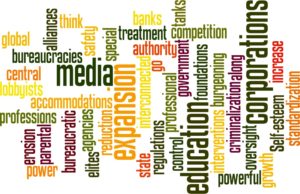An interconnected web of alliances and accommodations link education, professions, media, government bureaucracies and agencies, corporations, foundations, think tanks, lobbyists, central banks, and global elites. These groups, individually and collectively, strive for power and expansion. The motives for power and expansion borrow from primal human needs for survival. Humans in hierarchical societies align with the formula “My work, my profession, my position, my title, myself – group fate is my fate.” Self-esteem and sense of safety rise and fall with the ebb and flow of group fortune. After all, survival is at stake.
Group identity similarly relies upon the disposition “to get along, go along”. This disposition finds its roots in Paleolithic history. Prior to the emergence of farming and herding, humans and their ancestors survived in small family groups. To deviate or challenge the group risked ostracism –and ostracism decreased the likelihood of survival. The astounding uniformity of group think among allied bureaucrats, professionals, foundations, and media is consistent with this ancient imperative.

Although human population is many times the population of prior centuries, the diversity, originality, and depth of opinion has not progressed in tandem. To the contrary, contemporary opinion is marked by uniformity. The psychoanalyst, Harmon Ephron, told a story of a woman he observed on a commuter ride who was chagrined that she could not find the review section of the New York Times, so she would know what to think about a play she had recently attended.
Uniformity of opinion exists not only because people have become accustomed not to think for themselves, but also because of the narrowing of news and political orientation in the public sphere. Around the turn of the 20th century, more than 15 daily and more than 100 weekly newspapers with diverse journalistic perspectives were published in New York City alone. Today with one third the population, the number has declined to 5 daily and fewer than 20 weekly newspapers. The shrinking of opinion is even more egregious for radio and television. In the 1980s, 90 per cent of US media was controlled by fifty companies; today, 90 per cent is controlled by six companies.
The expansion of media control, the growth of corporations and reduction of competition, the increase in bureaucratic regulations and special treatment for the powerful, the ever-increasing requirements for education, the erosion of parental authority simultaneous with the growth of state oversight, the burgeoning cry for professional interventions for all and everything, increasing criminalization, “standardization” of medical and psychiatric procedures, the grasping after ever more money by global elites, and, in essence, encroachment upon every aspect of the commons, human dialog, and behavior is an inevitable outgrowth of unexamined and unchecked primal dispositions.
